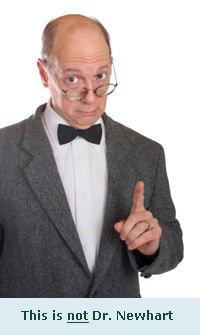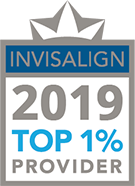Abbreviated History of Orthodontics
by Dr. Newhart
 Crowded, irregular, and protruding teeth have been a problem for some individuals since antiquity, and attempts to correct this disorder go back to at least 1000 BC. Primitive orthodontic appliances have been found in Greek, Etruscan, and Roman archeological sites.
Crowded, irregular, and protruding teeth have been a problem for some individuals since antiquity, and attempts to correct this disorder go back to at least 1000 BC. Primitive orthodontic appliances have been found in Greek, Etruscan, and Roman archeological sites.
As dentistry developed in the eighteenth and nineteenth centuries, a number of devices for the "regulation" of the teeth were described by various authors and were used sporadically by the dentists of that era.
Regulation was the word used for this area of dentistry until a French dentist named Dr. Lefoulon began to call his work with crooked teeth "orthodontisie." This was in the early 1800's.
About the time of the American Civil War, the devices used for tooth movement were becoming somewhat more refined. In the early 1800's a gold plate was often tied to the front of all teeth except those that were to be moved forward. The Plate was tied to the teeth by tiny wires, which are called "ligatures" today.
The practice of orthodontics or "regulating teeth," as it was called, grew rapidly in the 1880's and 1890's. This span of time was often called the "golden age of regulating," because of all the new methods of moving teeth that were developed. This was the first time that expanding the dental arch was popularized to make room for crowded teeth.
In the late 1800's and early 1900's, the early models of the headgear and neck gear were developed. An early design of a "Bite Plane" was made of vulcanite with a shelf fashioned on it. The appliance was placed in the mouth, bringing the lower jaw forward into occlusion with the upper. This "jumping the bite" laid the groundwork for the Bionator and the Herbst appliances, which are used today in our practice.
At this time, the emphasis in orthodontics remained the alignment of the teeth and the correction of facial proportions. Little attention was paid to the dental occlusion, and since it was common practice to remove teeth for many dental problems, extractions for crowding or malalignment were frequent. In an era when having all your teeth was a rarity, the details of good occlusal and dental relationships were considered unimportant!
In order to make good prosthetic replacement teeth, it was necessary to develop a concept of occlusion, and this occurred in the late 1800s. As the concepts of prosthetic occlusion developed and were refined, it was natural to extend this to the natural dentition. Edward H. Angle, whose influence began to be felt about 1890, can be credited with much of the development of a concept of occlusion in the natural dentition. Angle's original interest was in prosthodontics, and he taught in that department in the dental schools at Pennsylvania and Minnesota in the 1880s. His increasing interest in dental occlusion and in the treatment necessary to obtain normal occlusion led directly to his development of orthodontics as a specialty, with himself as the "father of modern orthodontics."
He helped to introduce a new sector in orthodontic thought, a system of classification and a terminology for diagnosing cases in order to treat them properly. Beginnings were made in 1885-1887. Edward Angle introduced such a classification thereby shaping orthodontics to the measures of a true science. His classification was founded on relations of the teeth, dental arches and jaws with the first permanent molar in the upper arch as a basic determining point.
In the 1880's the orthodontic profession began to add the rudiments of Biological considerations to the advances in mechanics through an observance of the effect of force and pressure on moving teeth. Constant and intermittent forces were studied and articles were widely printed in the dental magazines. Shortly after, two books were published on the subject, which marked the first time orthodontics was the exclusive subject of a book.
Archeological sites allowed the study of skulls and dental occlusions throughout history. An emphasis on normal occlusion became the centerpiece of modern orthodontic treatment. In 1887 Davenport published "The Significance of the Natural Form and Arrangement of the Dental Arch of Man" which suggested that extraction of teeth was unnecessary and should be avoided whenever possible. Dr Henry Baker developed the idea of elastics or rubber bands, originally intended for his own private treatment of his son's malocclusion.
Modern orthodontic treatment is a Biological art that is efficient, comfortable and rapid in correcting dental and skeletal malocclusions. Without the pioneers that struggled throughout history, today's accomplishments would not be possible.



